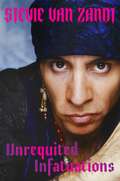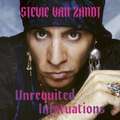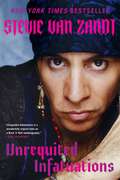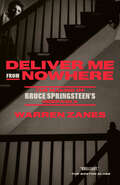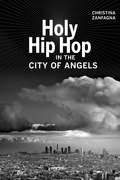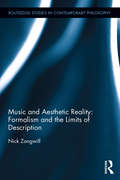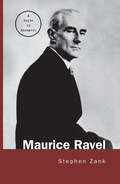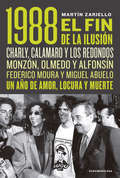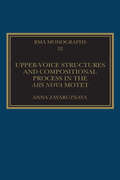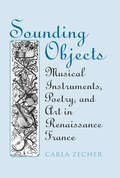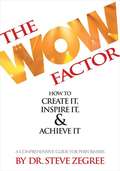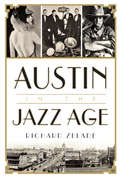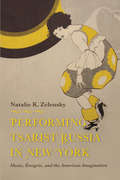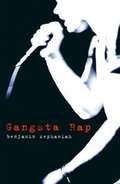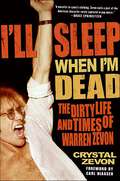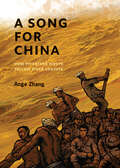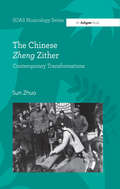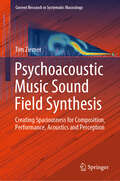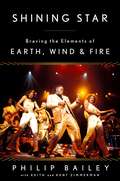- Table View
- List View
Unrequited Infatuations: A Memoir
by Stevie Van Zandt'A wonderfully original take on a Rock and Roll autobiography' Paul McCartney'An inimitable Rock 'n' Roll life told as boldly as it was lived' Bruce SpringsteenWhat story begins in a bedroom in suburban New Jersey in the early '60s, unfolds on some of the country's largest stages, and then ranges across the globe, demonstrating over and over again how Rock and Roll has the power to change the world for the better? This story.The first true heartbeat of UNREQUITED INFATUATIONS is the moment when Stevie Van Zandt trades in his devotion to the Baptist religion for an obsession with Rock and Roll. Groups like the Beatles and the Rolling Stones created new ideas of community, creative risk, and principled rebellion. They changed him forever. While still a teenager, he met Bruce Springsteen, a like-minded outcast/true believer who became one of his most important friends and bandmates. As Miami Steve, Van Zandt anchored the E Street Band as they conquered the Rock and Roll world.And then, in the early '80s, Van Zandt stepped away from E Street to embark on his own odyssey. He refashioned himself as Little Steven, a political songwriter and performer, fell in love with Maureen Santoro who greatly expanded his artistic palette, and visited the world's hot spots as an artist/journalist to not just better understand them, but to help change them. Most famously, he masterminded the recording of "Sun City," an anti-apartheid anthem that sped the demise of South Africa's institutionalized racism and helped get Nelson Mandela out of prison.By the '90s, Van Zandt had lived at least two lives-one as a mainstream rocker, one as a hardcore activist. It was time for a third. David Chase invited Van Zandt to be a part of his new television show, the Sopranos-as Silvio Dante, he was the unconditionally loyal consiglieri who sat at the right hand of Tony Soprano (a relationship that oddly mirrored his real-life relationship with Bruce Springsteen).Underlying all of Van Zandt's various incarnations was a devotion to preserving the centrality of the arts, especially the endangered species of Rock. In the twenty-first century, Van Zandt founded a groundbreaking radio show (Underground Garage), a fiercely independent record label (Wicked Cool), and developed a curriculum to teach students of all ages through the medium of music history. He also rejoined the E Street Band for what has now been a twenty-year victory lap.UNREQUITED INFATUATIONS chronicles the twists and turns of Stevie Van Zandt's always surprising life. It is more than just the testimony of a globe-trotting nomad, more than the story of a groundbreaking activist, more than the odyssey of a spiritual seeker, and more than a master class in rock and roll (not to mention a dozen other crafts). It's the best book of its kind because it's the only book of its kind.
Unrequited Infatuations: A Memoir
by Stevie Van Zandt'A wonderfully original take on a Rock and Roll autobiography' Paul McCartney'An inimitable Rock 'n' Roll life told as boldly as it was lived' Bruce SpringsteenWhat story begins in a bedroom in suburban New Jersey in the early '60s, unfolds on some of the country's largest stages, and then ranges across the globe, demonstrating over and over again how Rock and Roll has the power to change the world for the better? This story.The first true heartbeat of UNREQUITED INFATUATIONS is the moment when Stevie Van Zandt trades in his devotion to the Baptist religion for an obsession with Rock and Roll. Groups like the Beatles and the Rolling Stones created new ideas of community, creative risk, and principled rebellion. They changed him forever. While still a teenager, he met Bruce Springsteen, a like-minded outcast/true believer who became one of his most important friends and bandmates. As Miami Steve, Van Zandt anchored the E Street Band as they conquered the Rock and Roll world.And then, in the early '80s, Van Zandt stepped away from E Street to embark on his own odyssey. He refashioned himself as Little Steven, a political songwriter and performer, fell in love with Maureen Santoro who greatly expanded his artistic palette, and visited the world's hot spots as an artist/journalist to not just better understand them, but to help change them. Most famously, he masterminded the recording of "Sun City," an anti-apartheid anthem that sped the demise of South Africa's institutionalized racism and helped get Nelson Mandela out of prison.By the '90s, Van Zandt had lived at least two lives-one as a mainstream rocker, one as a hardcore activist. It was time for a third. David Chase invited Van Zandt to be a part of his new television show, the Sopranos-as Silvio Dante, he was the unconditionally loyal consiglieri who sat at the right hand of Tony Soprano (a relationship that oddly mirrored his real-life relationship with Bruce Springsteen).Underlying all of Van Zandt's various incarnations was a devotion to preserving the centrality of the arts, especially the endangered species of Rock. In the twenty-first century, Van Zandt founded a groundbreaking radio show (Underground Garage), a fiercely independent record label (Wicked Cool), and developed a curriculum to teach students of all ages through the medium of music history. He also rejoined the E Street Band for what has now been a twenty-year victory lap.UNREQUITED INFATUATIONS chronicles the twists and turns of Stevie Van Zandt's always surprising life. It is more than just the testimony of a globe-trotting nomad, more than the story of a groundbreaking activist, more than the odyssey of a spiritual seeker, and more than a master class in rock and roll (not to mention a dozen other crafts). It's the best book of its kind because it's the only book of its kind.
Unrequited Infatuations: A Memoir
by Stevie Van ZandtUncover never-before-told stories in this epic tale of self-discovery by a Rock n Roll disciple and member of the E Street Band. <p><p> What story begins in a bedroom in suburban New Jersey in the early '60s, unfolds on some of the country's largest stages, and then ranges across the globe, demonstrating over and over again how Rock and Roll has the power to change the world for the better? This story. <p><p> The first true heartbeat of Unrequited Infatuations is the moment when Stevie Van Zandt trades in his devotion to the Baptist religion for an obsession with Rock and Roll. Groups like the Beatles and the Rolling Stones created new ideas of community, creative risk, and principled rebellion. They changed him forever. While still a teenager, he met Bruce Springsteen, a like-minded outcast/true believer who became one of his most important friends and bandmates. As Miami Steve, Van Zandt anchored the E Street Band as they conquered the Rock and Roll world. And then, in the early '80s, Van Zandt stepped away from E Street to embark on his own odyssey. He refashioned himself as Little Steven, a political songwriter and performer, fell in love with Maureen Santoro who greatly expanded his artistic palette, and visited the world’s hot spots as an artist/journalist to not just better understand them, but to help change them. Most famously, he masterminded the recording of “Sun City,” an anti-apartheid anthem that sped the demise of South Africa’s institutionalized racism and helped get Nelson Mandela out of prison. <p><p> By the '90s, Van Zandt had lived at least two lives—one as a mainstream rocker, one as a hardcore activist. It was time for a third. David Chase invited Van Zandt to be a part of his new television show, the Sopranos—as Silvio Dante, he was the unconditionally loyal consiglieri who sat at the right hand of Tony Soprano (a relationship that oddly mirrored his real-life relationship with Bruce Springsteen). Underlying all of Van Zandt's various incarnations was a devotion to preserving the centrality of the arts, especially the endangered species of Rock. <p><p> In the twenty-first century, Van Zandt founded a groundbreaking radio show (Little Steven's Underground Garage), created the first two 24/7 branded music channels on SiriusXM (Underground Garage and Outlaw Country), started a fiercely independent record label (Wicked Cool), and developed a curriculum to teach students of all ages through the medium of music history. He also rejoined the E Street Band for what has now been a twenty-year victory lap. Unrequited Infatuations chronicles the twists and turns of Stevie Van Zandt’s always surprising life. It is more than just the testimony of a globe-trotting nomad, more than the story of a groundbreaking activist, more than the odyssey of a spiritual seeker, and more than a master class in rock and roll (not to mention a dozen other crafts). It's the best book of its kind because it's the only book of its kind.
Deliver Me from Nowhere: The Making of Bruce Springsteen's Nebraska
by Warren ZanesThe fascinating story behind the making of Bruce Springsteen&’s most surprising album, Nebraska, revealing its pivotal role in Springsteen&’s career Without Nebraska, Bruce Springsteen might not be who he is today. The natural follow-up to Springsteen&’s hugely successful album The River should have been the hit-packed Born in the U.S.A. But instead, in 1982, he came out with an album consisting of a series of dark songs he had recorded by himself, for himself. But more than forty years later, Nebraska is arguably Springsteen&’s most important record—the lasting clue to understanding not just his career as an artist and the vision behind it, but also the man himself. Nebraska is rough and unfinished, recorded on cassette tape with a simple four-track recorder by Springsteen, alone in his bedroom, just as the digital future was announcing itself. And yet Springsteen now considers it his best album. Nebraska expressed a turmoil that was reflective of the mood of the country, but it was also a symptom of trouble in the artist&’s life, the beginnings of a mental breakdown that Springsteen would only talk about openly decades after the album&’s release. Warren Zanes spoke to many people involved with making Nebraska, including Bruce Springsteen himself. He also interviewed more than a dozen celebrated artists and musical insiders, from Rosanne Cash to Steven Van Zandt, about their reactions to the album. Zanes interweaves these conversations with inquiries into the myriad cultural touchpoints, including Terrence Malick&’s Badlands and the short stories of Flannery O&’Conner, that influenced Springsteen as he was writing the album&’s haunting songs. The result is a textured and revelatory account of not only a crucial moment in the career of an icon but also a record that upended all expectations and predicted a home-recording revolution.
Holy Hip Hop in the City of Angels
by Christina ZanfagnaA free ebook version of this title is available through Luminos, University of California Press’s Open Access publishing program for monographs. Visit www.luminosoa.org to learn more. In the 1990s, Los Angeles was home to numerous radical social and environmental eruptions. In the face of several major earthquakes and floods, riots and economic insecurity, police brutality and mass incarceration, some young black Angelenos turned to holy hip hop—a movement merging Christianity and hip hop culture—to “save” themselves and the city. Converting street corners to open-air churches and gangsta rap beats into anthems of praise, holy hip hoppers used gospel rap to navigate complicated social and spiritual realities and to transform the Southland’s fractured terrains into musical Zions. Armed with beats, rhymes, and bibles, they journeyed through black Lutheran congregations, prison ministries, African churches, reggae dancehalls, hip hop clubs, Nation of Islam meetings, and Black Lives Matter marches. Zanfagna’s fascinating ethnography provides a contemporary and unique view of black LA, offering a much-needed perspective on how music and religion intertwine in people's everyday experiences.
Music and Aesthetic Reality: Formalism and the Limits of Description (Routledge Studies in Contemporary Philosophy)
by Nick ZangwillIn this volume, Zangwill develops a view of the nature of music and our experience of music that foregrounds the aesthetic properties of music. He focuses on metaphysical issues about aesthetic properties of music, psychological issues about the nature of musical experience, and philosophy of language issues about the metaphorical nature of aesthetic descriptions of music. Among the innovations of this book, Zangwill addresses the limits of literal description, generally, and in the aesthetic case. He also explores the social and political issues about musical listening, which tend to be addressed more in continental traditions.
Maurice Ravel: A Guide to Research (Routledge Music Bibliographies)
by Stephen ZankMaurice Ravel: A Research and Information Guide is an annotated bibliography concerning both the nature of primary sources related to the composer and the scope and significance of the secondary sources which deal with him, his compositions, and his influence as a composer and theorist.
1988. El fin de la ilusión: Charly, Calamaro y los Redondos; Monzón, Olmedo, Asís y Alfonsín; Federico Moura y Miguel Abuelo. Un año de amor, locura y muerte.
by Martín ZarielloUna semblanza divertida y reflexiva sobre 1988, un año bisagra en el rock nacional y en la vida cultural, política y social del país. Martín Zariello pone su lupa pop en el paisaje agridulce de esa época. El año en que -recién acababa de irse de este mundo Luca- mueren Federico Moura y Miguel Abuelo, el primer gobierno del retorno democrático entra en crisis y con él, el sueño entero de una generación parece desvanecerse. Una semblanza divertida y reflexiva sobre 1988, un año bisagra en el rock nacional y en la vida cultural, política y social del país. Como un rompecabezas, piezas aparentemente inconexas con los rostros de Alfonsín, Charly García, Luis Alberto Spinetta, Carlos Monzón, Cerati, Los Redonditos, Fito Páez, Alberto Olmedo, Rico & Seineldín y hasta Ricardo Piglia y Jorge Asís forman la trama de un año que, a tres décadas, pide urgente una revisión que soslaye las trampas de la nostalgia. Martín Zariello pone su lupa pop en el paisaje agridulce de ese año bisagra. El año en que -recién acaba de morir Luca- mueren Federico Moura y Miguel Abuelo, el primer gobierno del retorno democrático entra en crisis y con él, el sueño entero de una generación parece desvanecerse. Los capítulos: Alfonsín Live on tour 88 - Maral 39 - Amnesty es un lugar del que nadie puede regresar - Hipótesis alrededor de una canción de Cacho Castaña - Argentinos pero simpáticos - Pelusón of Foucault - Todos los femicidios, el femicidio - Sida intelectual - Te tendrás que cuidar - Los años del "rock pobre" -El amor antes del amor - Spaguetti del rock - La vanguardia era así - El futuro ya llegó
The Lucy Variations
by Sara ZarrLucy Beck-Moreau once had a promising future as a concert pianist. The right people knew her name, her performances were booked months in advance, and her future seemed certain.That was all before she turned fourteen.Now, at sixteen, it's over. A death, and a betrayal, led her to walk away. That leaves her talented ten-year-old brother, Gus, to shoulder the full weight of the Beck-Moreau family expectations. Then Gus gets a new piano teacher who is young, kind, and interested in helping Lucy rekindle her love of piano -- on her own terms. But when you're used to performing for sold-out audiences and world-famous critics, can you ever learn to play just for yourself?National Book Award finalist Sara Zarr takes readers inside one girl's struggle to reclaim her love of music and herself. To find joy again, even when things don't go according to plan. Because life isn't a performance, and everyone deserves the chance to make a few mistakes along the way.se life isn't a performance, and everyone deserves the chance to make a few mistakes along the way.
A Song Called Home
by Sara ZarrFrom award-winning author Sara Zarr comes a story of the small moments that show us who we are, and how family is not just something you’re part of, but something you make.Lou and her family don’t have much, but for Lou it's enough. Mom. Her sister, Casey. Their apartment in the city. Her best friend, Beth. It would be better if Dad could stop drinking and be there for her and Casey, and if they didn't have to worry about money all the time. But Lou doesn’t need better—she only needs enough.What’s enough for Lou, however, is not enough for Mom. Steve, Mom's boyfriend, isn’t a bad guy, he's just…not what Lou is used to. And now, he and Mom are getting married, and that means moving. Packing up life as they’ve known it and storing it in Steve’s garage. Lou will be separated from everything in her small but predictable life, farther from Dad than ever.Their last night in the city, Lou receives a mysterious birthday gift: A guitar, left for her by their front door. There’s nothing saying who left it, but it must be from Dad. And as she leaves the only place she’s ever known, she starts to believe that if she can learn how to play it, maybe she can bring a piece of him, and of her old life, home.
The Monstrous New Art
by Anna ZayaruznayaLate medieval motet texts are brimming with chimeras, centaurs and other strange creatures. In The Monstrous New Art, Anna Zayaruznaya explores the musical ramifications of this menagerie in the works of composers Guillaume de Machaut, Philippe de Vitry, and their contemporaries. Aligning the larger forms of motets with the broad sacred and secular themes of their texts, Zayaruznaya shows how monstrous or hybrid exempla are musically sculpted by rhythmic and textural means. These divisive musical procedures point to the contradictory aspects not only of explicitly monstrous bodies, but of such apparently unified entities as the body politic, the courtly lady, and the Holy Trinity. Zayaruznaya casts a new light on medieval modes of musical representation, with profound implications for broader disciplinary narratives about the history of text-music relations, the emergence of musical unity, and the ontology of the musical work.
Upper-Voice Structures and Compositional Process in the Ars Nova Motet (Royal Musical Association Monographs)
by Anna ZayaruznayaIn the motets of Philippe de Vitry, Guillaume de Machaut, and their contemporaries, tenors have often been characterized as the primary shaping forces, prior in conception as well as in construction to the upper voices. Tenors are shaped by the interaction of talea and color, medieval terms now used to refer to the independent repetition of rhythms and pitches, respectively. The presence in the upper voices of the periodically repeating rhythmic patterns, often referred to as "isorhythm," has been characterized as an amplification of tenor structure. But a fresh look at the medieval treatises suggests a revised analytical vocabulary: for many fourteenth- and fifteenth-century writers, both color and talea involved rhythmic repetition, the latter in the upper voices specifically. And attention to upper-voice taleae independently of tenor structures brings renewed emphasis to the significant portion of the repertory in which upper voices evince formal schemes that differ from those in the tenors. These structures in turn suggest a revision of the presumed compositional process for motets, implying that in some cases upper-voice text and forms may have preceded the selection and organization of tenors. Such revisions have implications for hermeneutic endeavors, since not only the forms of motet voices but the meanings of their texts change, depending on whether analysis proceeds from the tenor up, or from the top down. Where the presumed compositional and structural primacy afforded to tenors has encouraged a strand of interpretation that reads the upper-voice poetry as conforming to, and amplifying, the tenor text snippets and their liturgical contexts, a "bottom-down" view casts tenors in a supporting role and reveals the poetic impulse of the upper voices as the organizing principle of motets.
Zayn
by ZaynThe first and only official book from ZAYN. Global superstar ZAYN shares a photographic journey of his life since leaving One Direction. ZAYN opens up with this collection of thoughts, inspiration, and never-before-seen personal photographs. After five years of massive success with One Direction, ZAYN launched his career as a solo artist with Mind of Mine, becoming one of the most successful artists in the world. Now, for the first time ever, ZAYN is going to tell and show all in this intimate and raw scrapbook of his life. Never-before-released photos give readers insight to ZAYN, no-holds-barred. Gorgeously designed with hundreds of full-color photographs and ZAYN's notes, drawings, song lyrics, and personal stories, the book captures ZAYN's most private moments and his candid feelings on fame, success, music, and life. The next chapter of ZAYN's evolution into global superstar, told by the artist who is living it. *** Reviews for Mind of Mine: "A singer eager to reclaim the parts of himself that five years in the pop klieg lights forced into the shadows."--The New York Times "Sonically, you won't find many pop albums in 2016 more immaculately conceived than this."--SPIN "Sublime."--USA Today "Malik can sing . . . he's done this before, but not like this."--Rolling Stone "A moody, deeply textured R&B album..."--Los Angeles Times "Zayn has clearly achieved his aim of making an album of sexy, credible pop-R&B."--NMEFrom the Hardcover edition.
Sounding Objects
by Carla ZecherOften abstracted by the aesthetic implications of music itself, musical instruments can be seen as physical signifiers apart from the music that they produce. In Sounding Objects, Carla Zecher studies the representation of musical instruments in French Renaissance poetry and art, arguing that the efficacy of these material objects as literary and pictorial images was derived from their physical characteristics and acoustic properties, as well as from their aesthetic product.Sounding Objects is concerned with ways in which musical culture provided poets with a rich, nuanced vocabulary for reflecting on their own art and its roles in courtly life, the civic arena, and salon society. Poets not only depicted the world of musical practice but also appropriated it, using musical instruments figuratively to establish their literary identities. Drawing on music treatises and archival sources as well as poems, paintings, and engravings, this unique study aims to enrich our understanding of the interplay of poetry, music, and art in this period, and highlights the importance of musical materiality to Renaissance culture. Disclaimer: Images removed at the request of the rights holder.
The Wow Factor: A Comprehensive Guide for Performers
by Steve ZegreeDr. Steve Zegree of Western Michigan University, choral arranger and conductor of Western Michigan's Gold Company has developed this practical guide for performers, students, teachers and parents which offers fundamental philosophies and concepts that are essential to a person's growth and development and will contribute to a successful professional life in music.
Austin in the Jazz Age
by Richard ZeladeThough renowned, Austin's contemporary music scene pales in comparison with the explosion of creative talent the city spawned during the Jazz Age. Dozens of musicians who started out in the capital city attained national and international fame--but music was just one form of artistic expression that marked that time of upheaval. World War I's death and destruction bred a vehement rejection of the status quo. In its place, an enthusiastic adherence to life lived without question or consequence took root. The sentiment found fertile soil in Austin, with the University of Texas at the epicenter. Students indulged in the debauchery that typified the era, scandalizing Austin and Texas at large as they introduced a freewheeling, individualistic attitude that now defines the city. Join author Richard Zelade in a raucous investigation of the day and its most outstanding and outlandish characters.
Performing Tsarist Russia in New York: Music, Émigrés, and the American Imagination (Russian Music Studies)
by Natalie K. ZelenskyAn examination of the popular music culture of the post-Bolshevik Russian emigration and the impact made by this group on American culture and politics.Performing Tsarist Russia in New York begins with a rich account of the musical evenings that took place in the Russian émigré enclave of Harlem in the 1920s and weaves through the world of Manhattan’s Russian restaurants, Tin Pan Alley industry, Broadway productions, 1939 World’s Fair, Soviet music distributors, postwar Russian parish musical life, and Cold War radio programming to close with today’s Russian ball scene, exploring how the idea of Russia Abroad has taken shape through various spheres of music production in New York over the course of a century. Engaging in an analysis of musical styles, performance practice, sheet music cover art, the discourses surrounding this music, and the sonic, somatic, and social realms of dance, author Natalie K. Zelensky demonstrates the central role played by music in shaping and maintaining the Russian émigré diaspora over multiple generations as well as the fundamental paradox underlying this process: that music’s sustaining power in this case rests on its proclivity to foster collective narratives of an idealized prerevolutionary Russia while often evolving stylistically to remain relevant to its makers, listeners, and dancers. By combining archival research with fieldwork and interviews with Russian émigrés of various generations and emigration waves, Zelensky presents a close historical and ethnographic examination of music’s potential as an aesthetic, discursive, and social space through which diasporans can engage with an idea of a mythologized homeland, and, in turn, the vital role played by music in the organization, development, and reception of Russia Abroad.
Performing Tsarist Russia in New York: Music, Émigrés, and the American Imagination (Russian Music Studies)
by Natalie K. ZelenskyAn examination of the popular music culture of the post-Bolshevik Russian emigration and the impact made by this group on American culture and politics.Performing Tsarist Russia in New York begins with a rich account of the musical evenings that took place in the Russian émigré enclave of Harlem in the 1920s and weaves through the world of Manhattan’s Russian restaurants, Tin Pan Alley industry, Broadway productions, 1939 World’s Fair, Soviet music distributors, postwar Russian parish musical life, and Cold War radio programming to close with today’s Russian ball scene, exploring how the idea of Russia Abroad has taken shape through various spheres of music production in New York over the course of a century. Engaging in an analysis of musical styles, performance practice, sheet music cover art, the discourses surrounding this music, and the sonic, somatic, and social realms of dance, author Natalie K. Zelensky demonstrates the central role played by music in shaping and maintaining the Russian émigré diaspora over multiple generations as well as the fundamental paradox underlying this process: that music’s sustaining power in this case rests on its proclivity to foster collective narratives of an idealized prerevolutionary Russia while often evolving stylistically to remain relevant to its makers, listeners, and dancers. By combining archival research with fieldwork and interviews with Russian émigrés of various generations and emigration waves, Zelensky presents a close historical and ethnographic examination of music’s potential as an aesthetic, discursive, and social space through which diasporans can engage with an idea of a mythologized homeland, and, in turn, the vital role played by music in the organization, development, and reception of Russia Abroad.
Gangsta Rap
by Benjamin ZephaniahSchool, what school? My name is X-Ray-X So be careful how you flex I used to freestyle in me bedroom. But me daddy got me vex. The teacher kicked me out of the classroom. Now I'm rapping in The Rex. Ray has trouble at home and trouble at school. It's the last straw for everyone when Ray and his friends Prem and Tyrone are permanently suspended. But they know what they want, more than most, perhaps. Their headmaster decides to give them a second chance, a chance to live their dream of forming a rap group. Through a specialized social program, the boys are taught the business of the music industry, what it takes to record an album, and how to lay down a track. Within weeks they have become the Positive Negatives, and within a few months they have signed a record deal and are on their way to the top. But their dream soon becomes a nightmare as violence escalates around them. Suddenly, not only their careers but their very lives are at stake. The Positive Negatives are determined to prove that you don't need to be a gangster to be a great rapper.
I'll Sleep When I'm Dead: The Dirty Life and Times of Warren Zevon
by Crystal ZevonWhen Warren Zevon died in 2003, he left behind a rich catalog of dark, witty rock 'n' roll classics, including "Lawyers, Guns and Money," "Excitable Boy," and the immortal "Werewolves of London." He also left behind a fanatical cult following and veritable rock opera of drugs, women, celebrity, genius, and epic bad behavior. As Warren once said, "I got to be Jim Morrison a lot longer than he did."Narrated by his former wife and longtime co-conspirator, Crystal Zevon, this intimate and unusual oral history draws on interviews with Bruce Springsteen, Stephen King, Bonnie Raitt, and numerous others who fell under Warren's mischievous spell. Told in the words and images of the friends, lovers, and legends who knew him best, I'll Sleep When I'm Dead captures Warren Zevon in all his turbulent glory.
A Song for China: How My Father Wrote Yellow River Cantata
by Ange ZhangPublished in celebration of the famous Yellow River Cantata’s 80th anniversary, this is the riveting history of how a young Chinese author and passionate militant fought using art to create a socially just China during the period of the struggle against the Japanese and during World War II.This is the fascinating story of how a young Chinese author, Guang Weiran, a passionate militant from the age of twelve, fought, using art, theater, poetry and song, especially the famous Yellow River Cantata — the anthem of Chinese national spirit — to create a socially just China. Set during the period of the struggle against the Japanese and the war against the Kuomintang in the 1920s and ’30s, this book, written and illustrated by Guang Weiran’s award-winning artist son, Ange Zhang, illuminates a key period in China’s history. The passion and commitment of the artists who were born under the repressive weight of the Japanese occupation, the remnants of the decaying imperial order and the times of colonial humiliation are inspiring.Zhang’s words and wood-block style of art tell us the story of his father’s extraordinary youth and very early rise to prominence due to his great talent with words. We see and hear the intensity of what it meant to be alive at such a significant moment in the history of China, a country that understands itself as the heir to one of the greatest civilizations the world has ever known. The humiliations and social injustice the Chinese people had endured in the colonial period were no longer bearable. And yet there were major factional differences between those who wanted to create a modern China. Ange’s words and art paint the picture for us through his father’s story, accompanied by sidebars that explain the historical context.The book ends in a burst of glorious color and song, with the words of Yellow River Cantata in Mandarin, as well as newly translated into English. This great song turns eighty years old in 2019, and will be sung and performed by huge orchestras and choirs around the world, as the Chinese diaspora has embraced the cantata as its own.Key Text Features historical context sidebars illustrations lyricsCorrelates to the Common Core State Standards in English Language Arts:CCSS.ELA-LITERACY.RI.6.2 Determine a central idea of a text and how it is conveyed through particular details; provide a summary of the text distinct from personal opinions or judgments.CCSS.ELA-LITERACY.RI.6.6 Determine an author's point of view or purpose in a text and explain how it is conveyed in the text.CCSS.ELA-LITERACY.RI.6.7 Integrate information presented in different media or formats (e.g., visually, quantitatively) as well as in words to develop a coherent understanding of a topic or issue.
The Chinese Zheng Zither: Contemporary Transformations (SOAS Musicology Series)
by Sun ZhuoThe zheng zither is one of the most popular instruments in contemporary China. It is commonly regarded as a solo instrument with a continuous tradition dating back to ancient times. But in fact, much of its contemporary solo repertory is derived from several different regional folk ensemble repertories of the mid-twentieth century. Since the setting up of China’s modern conservatories, the zheng has been transformed within these new contexts of professional music-making. Over the course of the twentieth century, these regional folk repertories were brought into the performance traditions of modern regional zheng schools. From this basis, a large new zheng repertory was created by conservatory musicians, combining aspects of Western classical music with folk music materials. With the ’opening up’ of China’s economy since the 1980s, the zheng has been brought into the wider stage of international music-making which includes contemporary art music compositions by overseas based Chinese composers and commercial world music works by Western composers. Through a series of case studies, this book explores how the transformation of the Chinese zheng has constantly responded to its changing social context, critiquing the long-standing arguments concerning ’authenticity’ in the development of tradition. This work arises out of, and reflects on, the research methodologies known as performance as research. As an insider to the tradition, brought up within China’s zheng society, a trained and practising zheng performer, this study is largely drawn from the author's own experiences of practising and performing the music in question; her study also draws on fieldwork, as well as primary and secondary written sources in Chinese and English. This book is accompanied by a DVD which contains audio visual materials relating to the author's fieldwork and zheng performances by different zheng musicians.
Psychoacoustic Music Sound Field Synthesis: Creating Spaciousness for Composition, Performance, Acoustics and Perception (Current Research in Systematic Musicology #7)
by Tim ZiemerThis book provides a broad overview of spaciousness in music theory, from mixing and performance practice, to room acoustics, psychoacoustics and audio engineering, and presents the derivation, implementation and experimental validation of a novel type of spatial audio system. Discussing the physics of musical instruments and the nature of auditory perception, the book enables readers to precisely localize synthesized musical instruments while experiencing their timbral variance and spatial breadth.Offering interdisciplinary insights for novice music enthusiasts and experts in the field of spatial audio, this book is suitable for anyone interested in the study of music and musicology and the application of spatial audio mixing, or those seeking an overview of the state of the art in applied psychoacoustics for spatial audio.
Psychoakustische Schallfeldsynthese für Musik: Raum schaffen für Komposition, Aufführung, Akustik und Wahrnehmung
by Tim ZiemerDieses Buch bietet einen umfassenden Überblick über die Räumlichkeit in der Musiktheorie, von der Abmischung und Aufführungspraxis bis hin zur Raumakustik, Psychoakustik und Tontechnik, und stellt die Ableitung, Implementierung und experimentelle Validierung eines neuartigen räumlichen Audiosystems vor. Durch die Erörterung der Physik von Musikinstrumenten und der Natur der auditiven Wahrnehmung ermöglicht das Buch den Lesern, synthetische Musikinstrumente präzise zu lokalisieren und gleichzeitig ihre klangliche Varianz und räumliche Weite zu erleben. Dieses Buch bietet interdisziplinäre Einblicke für Musikneulinge und Experten auf dem Gebiet der räumlichen Audiotechnik. Es eignet sich für alle, die sich für das Studium von Musik und Musikwissenschaft und die Anwendung von räumlichen Audiomischungen interessieren oder einen Überblick über den Stand der Technik in der angewandten Psychoakustik für räumliches Audio suchen.
Shining Star
by Keith Zimmerman Kent Zimmerman Philip BaileyA revealing and heartfelt memoir from the lead singer of the legendary Earth, Wind & Fire With more than ninety million records sold and eight Grammy awards throughout its forty-year history, Earth, Wind & Fire has staked its claim as one of the most successful, influential, and beloved acts in music history. Now, for the first time, its dynamic lead singer Philip Bailey chronicles the group's meteoric rise to stardom and his own professional and spiritual journey. Never before had a musical act crossed multiple styles and genres with a quixotic blend of astrology, Universalism, and Egyptology as Earth, Wind & Fire (EWF) did when it exploded into the public's conscience during the 1970s. The group's shows became sensory experiences with their dramatic staging, shimmering costumes, elaborate choreography, baffling magic tricks and a thumping backbeat. At the center of it the group was its charismatic founder Maurice White and Bailey, with his soaring multi-octave range and distinctive falsetto. After being signed by recording titan Clive Davis, EWF went on to produce a remarkable series of platinum and gold albums and headline stadiums around the world. As Philip and Maurice were profoundly influenced by genius producer Charles Stepney, as well as famed arranger David Foster, EWF elevated Sly Stone's multiethnic "I Wanna Take You Higher" message to an even higher level. Bailey hit the wall due to fame, fortune, and the excesses of global succes. The constant touring and performing took its toll on him publicly and privately. While White and Bailey's relentless work ethic shot the band into the stratosphere, it also exhausted and emotionally gutted the group. In 1983, White abruptly dismantled the band, leaving Bailey and the rest of the members to fend for themselves. As a solo act, Bailey recorded "Easy Lover," a worldwide smash duet with Phil Collins, launching the next stage of his career until EWF reunited later that decade. Shining Star is the true story of what happens when real life exceeds your dreams, when the power and pain of building a legacy brings both joy and faith-testing challenges.
